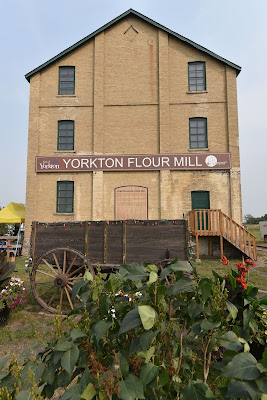Exploring (and Birding) Yorkton Saskatchewan
The town of Yorkton originated in 1882, when a group of businessmen and investors from Eastern Ontario formed the York Farmers Colonization Company and bought portions of six townships in the area around Little Whitesand River (now Yorkton Creek). Before they arrived, this land was part of the traditional territory of the Anishinabek and Métis, and it was later included in Treaty 4. The Yorkton businessmen established a trading centre at this spot that was known as York Colony. In 1889 a rail line was put in near York Colony, and the community was relocated to it's current position on the railway line.
As we walked around town we passed the Godfrey Dean Art Gallery and Cultural Centre. It is the only professionally-operated art gallery within a 150 km radius, and it curates, promotes, and exhibits the work of local, provincial, and national contemporary artists. Although the gallery sadly wasn't open when we visited, there was a thought provoking stone statue located right outside as well as two beautiful tile murals at its entrance.
As we made our way into downtown we also passed the Yorkton Armoury, where the 64th Field Battery, Royal Canadian Artillery is stationed. During WWII Yorkton was home to the No. 23 Elementary Flying Training School and the No. 11 Service Flying Training School which were both part of the British Commonwealth Air Training Plan.
We stopped downtown at the locally popular YDB Scoops for a delicious scoop of Saskatoon berry ice cream, and then made our way to the City Centre Park to check out the city murals.
One of the highlights of Yorkton for us was visiting the Ravine Ecological Preserve, which was a large cattail marsh at the edge of town. The Hjertaas Nature Trail was a pleasant footpath that wound around the lake, traversing a grassy area where interpretive signage pointed out the foundations remaining from an earlier settlement in the area. It took us out across the marsh on a floating footbridge, and brought us back to a grassy park with a pavilion and circle of conifers creating a Peace Park.
On our way back downtown we stopped at Shaw Park to explore the 'Doors of Opportunity' sculpture by the Cree artist Lionel Peychew. The 8 ft tall weathered steel sculpture is a rounded spiral with four doorways facing the cardinal directions. Laser cut-outs on the walls depict scenes from 100 years of history in Yorkton, and visitors are welcomed into the sculpture and invited to walk from the present, through the past, and back to the present with hope for the future.
Our last stop was at the historic Yorkton Flour Mill, where a Road Rally Fundraiser was being held. We'd seen signs for the Rally Round along the roads coming into town, and we learned it was part of a scenic drive with a purpose. The event included a pancake breakfast, barbecue, a cruise of cars down Broadway St., a show-and-shine, tickets to the beer garden and live music at the mill, and tickets to a drive-in movie. Participants drove around Yorkton, following clues and answering questions as they visited points of interest in an 'Amazing Race' style event. In exchange, participants raised money for the Firefighter's Burn Fund.
Outside the Flour Mill was a display of large panels explaining the history Yorkton, beginning with the time it was inhabited by First Nations. The panels show aerial photos of Yorkton from the 1920's, '50's, and '70's, showing how it changed and grew. The panels also provide information on the history of wheat, farming practices, and the development of the prairies.
Outside the music stage there was also a small garden exhibiting different kinds of wheat that are and were grown on the prairies. It was fascinating to see the different colours, shapes, and sizes of the two dozen varieties, and to see the work that was done in each stage, a lot of it by Dominion Experimental Farms, to make the wheat resistant to a different pest or problem. Marquis wheat had a shorter, thinner fruit, while Spelt had a long, braided-looking fruit, Kamut what had long dark hairs, and Emmer had a dark purplish-black fruit.
After exploring this fascinating bit of local history we returned to the mountain of work we are facing to catch up with our various obligations and projects. Visiting Yorkton has been an interesting and enjoyable experience.
See you on the trail!
Remember to follow our entire adventure here : www.comewalkwithus.online






































Comments
Post a Comment